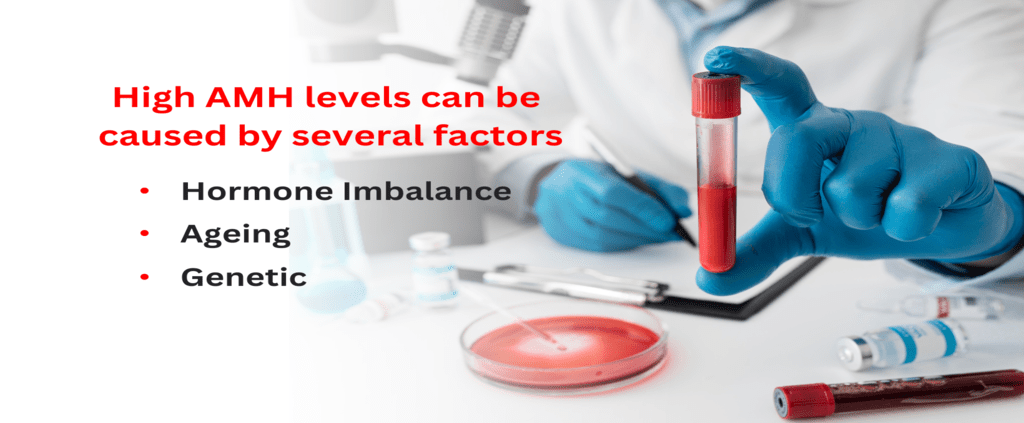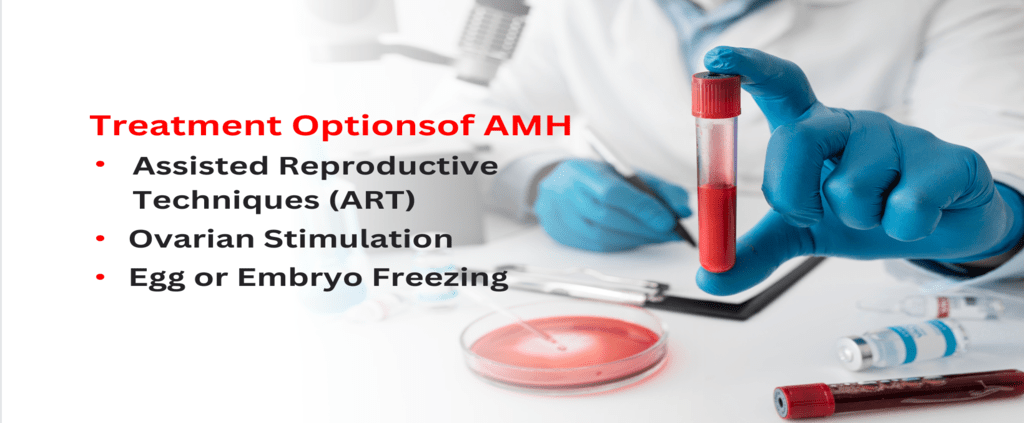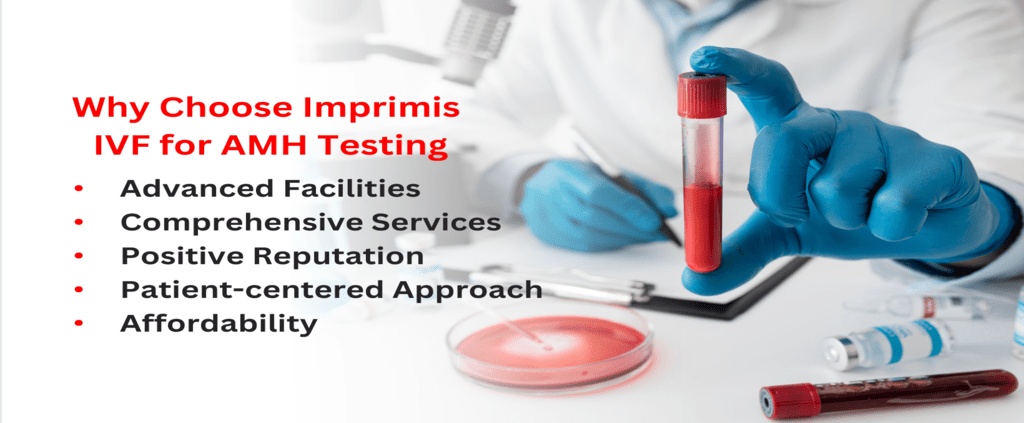Enlarged Uterus: Causes, Symptoms, and Treatment
Introduction to Enlarged Uterus
Enlarged Uterus – The uterus is a hollow organ in the pelvis and comprises two parts: the endometrium, which thickens during pregnancy, and the myometrium, which supports the uterus internally. Three layers comprise the uterus: the innermost layer is called the glandular or functional layer; this portion of the uterine wall secretes mucus and blood vessels that feed the endometrium.
The middle layer is called the serous or storage layer; this portion of the uterine wall stores blood in case of anemia. Finally, there is an outermost layer called muscular or adventitial; this portion of the uterine wall helps support and shape the uterus. A woman’s reproductive organs comprise her cervix, vagina, fallopian tubes, and ovaries (the ovary).
The term “enlarged uterus” describes a condition in which the size of the endometrium (uterine lining) increases beyond normal limits. The syndrome may start after menopause or present at birth and last for the rest of one’s life. Significant uterus syndrome is sometimes called leiomyomata.
The most common cause of significant uterus syndrome is an inherited disorder called uterine leiomyoma (unlike fibroids, leiomyomas are not cancerous). Leiomyomas are usually benign tumors composed of smooth muscle cells which frequently line the uterus’ interior. They can grow and increase over time, resulting in a larger uterus with an enlarged endometrium.
The most common cause of infertility is an enlarged uterus (endometriosis). An enlarged uterus can occur due to pelvic inflammatory disease (PID), endometriosis, or adenomyosis (a condition in which endometrial tissue grows outside of the uterus).
Causes of Enlarged Uterus
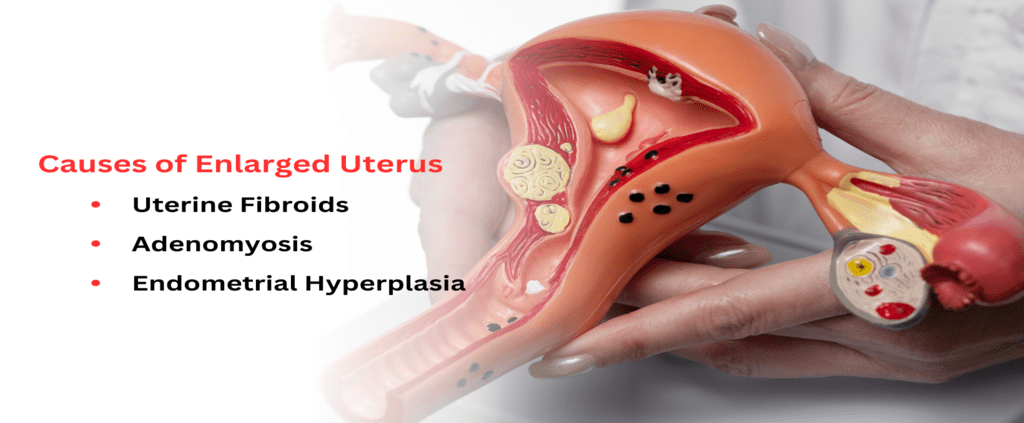
The common causes of an enlarged uterus may be medical illnesses in the background, like polycystic ovarian syndrome (PCOS), endometriosis, or pelvic inflammatory disease (PID). However, other factors, such as excessive weight gain or breastfeeding, can play a role occasionally.
1. Uterine Fibroids
Fibroids are benign tumors that usually occur in the uterus, although they can sometimes be found elsewhere in the body. The fibroid may be a single tumor, or it may consist of several smaller tumors. Fibroids can cause pain at the time of menstruation, as well as abnormal bleeding and other problems. If a woman thinks she has fibroids, she should see her doctor to get checked out.
2. Adenomyosis
Adenomyosis is when the muscle layer around your uterus becomes thick and lumpy instead of smooth and elastic like normal muscle tissue. This can cause problems with your periods and make them irregular or heavy, possibly leading to anemia or blood clots that may cause a stroke or a heart attack.
If you have adenomyosis, you may also experience painful cramps or bleeding between periods or irregular intervals during your cycle. Your doctor will check for adenomyosis based on the symptoms you report, your medical History, and any physical exam findings he observes during an exam of your cervix (the lower part of your uterus).
3. Endometrial Hyperplasia
Endometrial hyperplasia can develop if a woman has multiple risk factors for endometrial cancer, such as:
- Women after 35 years of age.
- Previous History of breast cancer
- History of blood clots in your veins (deep-vein thrombosis)
- Family history of endometrial cancer
- A family history of uterine polyps
Symptoms and Impact on Fertility
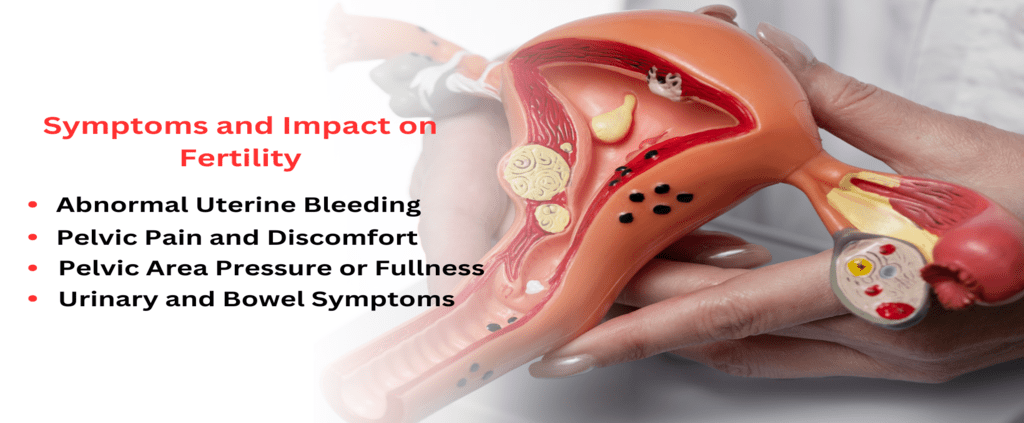
1. Abnormal Uterine Bleeding
Abnormal uterine bleeding can be a sign of an enlarged uterus. This is also known as menorrhagia. It occurs because the blood flow to the uterus is restricted due to an enlarged uterus. In most cases, it happens due to pregnancy and childbirth. An enlarged uterus may be to blame for lower back or abdomen pain and bleeding between periods.
2. Pelvic Pain and Discomfort
If your uterus has grown too large for its good, it may press against other organs in your pelvis (it comprises two bones: ilium and pubic bone). This pressure can cause pelvic pain, back pain, and lower abdominal discomfort. Another symptom is constipation due to pressure on the rectum from the enlarged uterus pressing against it during childbirth or periods (for example, during menopause).
3. Pelvic Area Pressure or Fullness
Pelvic pain and discomfort are common complaints of women with enlarged uteri. This can be due to pressure or fullness in the pelvis and may also result in spasms or cramping that can be uncomfortable for both you and your doctor to deal with.
4. Urinary and Bowel Symptoms
Urinary and bowel symptoms such as urgency, frequency, incontinence (leakage) of urine or stool, constipation, painful urination; sexual dysfunction including vaginal dryness or pain during intercourse
Diagnosing an Enlarged Uterus
1. Medical History and Examination
The medical history and physical examination should focus on ruling out pregnancy, fibroids, and cancer. Medical History includes:
- History of recent illnesses, injuries, or surgeries that may have affected the uterus.
- Any current or past health conditions may affect fertility or pregnancy, such as diabetes and high blood pressure.
- The woman’s age, race, and medical History should be considered when diagnosing a possible enlarged uterus since the condition is more common in older women than in young women.
2. Imaging Tests
The diagnosis is usually benign if an ultrasound shows an enlarged uterus with a thin wall. However, if there is no evidence of pregnancy (e.g., vaginal bleeding or missed period), the diagnosis may be more likely to be uterine fibroids or endometriosis. In this case, a laparoscopy may be performed to confirm the diagnosis and remove any fibroids if they are found during surgery. An MRI may also help assess the embryo’s viability so that it can be frozen for future use if needed.
3. Biopsy or Sampling
A biopsy sample can be obtained with laparoscopy; however, there are risks involved in obtaining this type of tissue (invasive surgery).
Treatment Options for Enlarged Uterus and Infertility
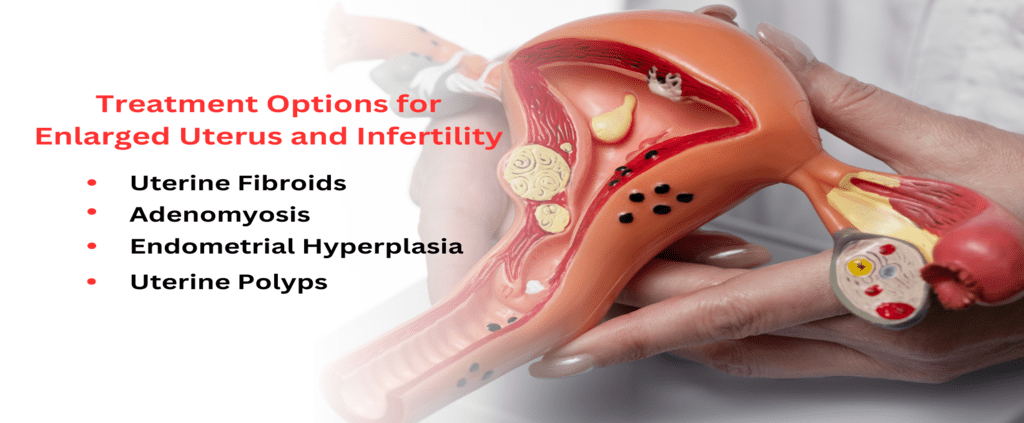
1. Uterine Fibroids
Uterine fibroids are benign tumors that grow in the fibrous lining of the uterus. Numerous symptoms, such as painful or irregular periods, heavy menstrual flow, pain during sex, or bowel motions, might be brought on by them. If fibroids push on the Fallopian tubes and prevent them from carrying eggs from the ovary to the uterus, this can also result in infertility.
2. Adenomyosis
Adenomyosis is when the lining of the uterus becomes thicker than usual and grows into adjacent tissues. The condition may cause infertility, abdominal pain, and urinary symptoms such as an increased need to urinate and blood in the urine.
3. Endometrial Hyperplasia
Endometrial hyperplasia is a disorder when the lining of the uterus experiences an increase in cells, thickening and expanding abnormally. Women with endometrial hyperplasia may have irregular periods or heavy bleeding.
4. Uterine Polyps
Uterine polyps are growths on the villi or fingerlike projections that line the end of the fallopian tubes — structures that carry eggs from ovaries to the uterus — or other body areas such as the cervix (neck of the womb). Polyps can cause cervical cancer if they become large enough to block the cervical opening (birth canal).
Fertility Treatment Planning and Considerations
An enlarged uterus is a common medical condition, which is more common in women of childbearing age. The uterus is the organ that holds and nourishes the developing fetus during pregnancy.
Although the exact etiology of this ailment is unknown, it could be brought on by hormone imbalances, pregnancy, tumors, growth hormones, or other factors. It usually affects women after the age of 35 and is more common in those with children.
1. Individualized Approach
For mild cases, there are no special considerations for fertility treatment. However, IVF Treatment may be considered if there is no chance of conceiving naturally. If there is a possibility of having problems conceiving later on, egg donation may be an option.
2. Collaboration with Fertility Specialists
In the case of a large size of uterus, Fertility specialists recommend surgical treatment for the removal of extra tissue or organ from the body or removing part of an organ from the body with minimized damage to surrounding tissues. The procedure has been successfully performed using laparoscopy(minimally invasive surgical technique), which provides several advantages like minimized pain during surgery, no open abdomen surgery required, and less risk of infection compared to open abdomen surgery like laparotomy.
Conclusion
It would be best to see a doctor to find the underlying cause of your enlarged uterus. Making an appointment with your gynecologist is an intelligent approach to accomplish this. Calling their office and making an appointment over the phone is an option if you cannot visit them in person.
A regular doctor will check your health history and ask questions about your menstrual cycle, fertility, family history, and other relevant information. They will also conduct a physical exam and ask you questions about your health. This way, they can look at all possible causes of your enlarged uterus and find suitable treatment options.
Why Choose Imprimis IVF for Enlarged Uterus Treatment
Imprimis IVF is ideal for enlarged uterus treatment due to its specialized expertise, advanced technology, comprehensive approach, diverse treatment options, and supportive care. Their team of experienced fertility specialists focuses exclusively on reproductive medicine, ensuring personalized and effective treatment for an enlarged uterus. Equipped with state-of-the-art facilities, Imprimis IVF provides accurate diagnosis and utilizes cutting-edge technology for optimal treatment outcomes.
Their holistic approach considers various factors contributing to the condition, addressing underlying causes and developing individualized treatment plans. Imprimis IVF ensures that patients receive the most appropriate and effective care with a wide range of treatment options available, including medications, minimally invasive procedures, and fertility preservation techniques.

